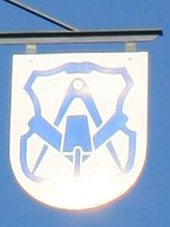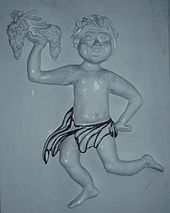Plasterer
Plasterer (since RSR in 2006 in Germany), Austria plasterer , is a job title for the interior design and facades make builders and related training occupation. The profession is in southern Germany and Switzerland plasterer called the North German it is cleaner or plasterers . In the official South German journeyman's letter , the term plasterer and plasterer is used .
job profile
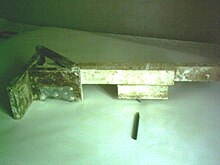
Plasterers plaster walls indoors and outdoors, produce lightweight construction walls and suspended ceilings from plasterboard ( drywall ) and Rabitz . Other important fields of work are the energetic renovation of buildings, for example with thermal insulation composite systems and the removal of mold infestation. Even solar ventilation systems, air-conditioned ceilings, sound insulation and plastered wall surface heating are now planned and installed by specialist plasterers.
The name gives the profession the work with stucco (plastic molding of mortar or plaster on plastered surfaces). This area of activity is still in demand today. Plasterers renovate, produce and process stucco. This job requires good training, a lot of experience and a sure instinct. Stucco parts can be prefabricated in the workshop as well as on site on the construction site. Depending on the place of installation on the building, a distinction is made between interior and exterior stucco. The combination of classic stucco techniques with modern coating techniques and modern design offers suitable implementation options for every building project.
Work equipment

Some of the main working tools of the plasterer: trowel , trowel , plasterer iron , trapeze bar , Vorziehlatte , metal shears , trowel , putty knife , spirit level , plumb , straight edge and possibly a cleaning machine / mixing pump for machine plaster application. Profile templates are often used to shape long straight or curved stucco profiles .
Working materials
The working materials include: gypsum and various limestones, lime mortar , and various plasters such as cement mortar, cement and clay plaster. Plasterboard, screeds and insulation are also used, among other things .
education
Germany
Traditionally, the job was done by men because it was or sometimes still is physically demanding work. Nowadays the job is made easier by machines and aids and is also suitable for women. In order to learn the profession of plasterer in a training company , you need at least a secondary school diploma . The apprenticeship as a plasterer takes three years in the dual training system and ends with the journeyman's examination . The practical part of the teaching takes place in the company or in inter-company courses and the theoretical part at the vocational school . The training ordinance, which has been in force since 1999, enables training that can be credited. This is how you get a professional qualification as a finishing worker after two years and with a subsequent year of training as a plasterer. After further training to become a master , plasterers can train to become restorers or set up their own business in the plastering trade. → Major certificate of proficiency . The independent exercise of the learned profession as a journeyman is prohibited by the restriction of trade freedom of the Chamber of Crafts .
As in all construction trades, after passing the journeyman's examination, there is the possibility of further training to become a factory or building foreman , but this does not differ much from the costs of the master craftsman's examination. Since 2008, the master’s title has been recognized as a general university entrance qualification and thus entitles to university studies . The journeyman's certificate together with three years of professional activity entitles you to study at a university of applied sciences . Subjects are, for example, building technology or building construction . Since 2015, applicants with a university entrance qualification have also been offered a seven-semester practical course to become an expansion manager, in which the qualifications of journeyman , master plasterer , building energy consultant and expansion manager can be acquired. The master craftsman's certificate in plastering is classified in the German and European qualifications framework like the bachelor's degree at level 6.
In individual state subject classes, training content in the field of color techniques and color design is increasingly being taught. In the regional associations and guilds organized in the Federal Association for Finishing and Facades, the plastering trades' businesses are advised in all matters on the basis of voluntary membership. The association also directs the stucco plastering drywall federal performance competition, which entitles the plasterers to participate in the WorldSkills .
Austria
In Austria, the official designation according to the Vocational Training Act (BAG) is plasterer and drywall builder . Austrian apprentices receive dual training for three years and take the final apprenticeship examination at the end . The training content is based on the job description, taking current developments into account.
After completing the apprenticeship, training to become a foreman or foreman can be completed. The independent professional practice is possible for plasterers in the regulated handicraft of plasterers and drywall builders as well as in the handicraft of heat, cold, sound and fire insulators.
Plasterers as artists
In the Renaissance , Baroque and Classicism periods , plasterers appear as important designers of predominantly church but also representative secular interiors. They are considered to be artists, as are the painters and sculptors they work with. A unique fusion of wall and ceiling frescoes with stucco and architecture is particularly successful in the Rococo . The trademark of the epoch is a stucco ornament : the rocaille . Often the plasterers themselves are architects , painters or ( plastering ) sculptors at the same time .
The Asam brothers , the brothers Johann Baptist and Dominikus Zimmermann , Joseph Schmuzer and the artist families Carlone and Feuchtmayer are among the most important plasterers in art history .
Plasterers of the 17th and 18th centuries, whose style was influenced by their training or work at the Bavarian Benedictine monastery Wessobrunn , are summarized under the term Wessobrunn School (coined in 1888) .
Plasterers were also the first to be used to create three-dimensional stage sets. Specializations, especially in the field of materials science, later developed into an independent profession, the theater sculptor .
To distinguish it from the handicraft plasterer, Stuckator refers to the plasterer .
List of important plasterers
in chronological order of the dates of birth
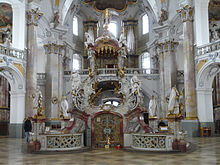
Years 1500 to 1599
- Perino del Vaga ( Pietro Buonaccorsi , 1501–1547), Italian painter and plasterer of the Renaissance
- Fedele Casella (verifiably 1522–1547), Italian sculptor and plasterer of the Renaissance
- Scipione Casella (verifiably 1543–1553), Italian sculptor, plasterer and silversmith of the Renaissance
Years 1600 to 1699
- Daniel Ankermann (around 1620 at Güstrow Castle )
- Johann Schmuzer (1642–1701), German plasterer (Wessobrunn school)
- Johann Jakob Herkomer (1648–1652), German builder, sculptor, painter and plasterer of the Baroque era
- Giovanni Simonetti (1652–1716), Swiss plasterer of the early and high baroque era
- Paolo d'Allio (1655–1729), Italian plasterer
- Franz Joseph Feuchtmayer (1660–1718), German plasterer
- Karl Engel ( Carlo Angelini , * before 1664, † after 1702), Swiss architect and plasterer of the Baroque
- Giovanni Giuliani (1664–1744), Italian-Austrian sculptor and plasterer of the Baroque
- Santino Bussi (1664 / 66–1736 / 37), Italian court plasterer in Austria
- Mrs. Stuckhatorin (1666–1670 active in the Kempten prince monastery )
- Pietro Francesco Appiani (1670–1724), Italian plasterer
- Giuseppe Volpini (1670–1729), Italian sculptor and plasterer of the Baroque
- Diego Carlone (1674–1750), Italian plasterer
- Alberto Camesina (1675–1756), Swiss baroque plasterer
- Johann Baptist Zimmermann (1680–1758), German painter and plasterer of the Baroque and Rococo periods
- Andrea Gallasini (1681–1766), Swiss baroque plasterer
- Joseph Schmuzer (1683–1752), German builder and plasterer of the Baroque and Rococo periods (Wessobrunn School)
- Dominikus Zimmermann (1685–1766), German builder and plasterer of the Rococo (Wessobrunn School)
- Charles Dubut (1687–1742), French sculptor, plasterer and bronze caster of the high baroque
- Riccardo Retti (1687–1741), Italian plasterer
- Jacopo Appiani (1687–1742), Italian rococo plasterer
- Paul Egell (1691–1752), German sculptor and plasterer of the early Rococo
- Egid Quirin Asam (1692–1750), German painter, sculptor and plasterer of the Rococo
- François de Cuvilliés the Elder (1695–1768), Belgian-German builder, sculptor and plasterer of the Rococo
- Joseph Anton Feuchtmayer (1696–1770), German sculptor and plasterer of the Rococo (Wessobrunn School)
- Johann Peter Heel (1696–1767), sculptor and plasterer
- Johann Baptist Modler (1697–1774), German sculptor and plasterer of the Rococo
Years 1700 to 1799
- Johannes Schütz (1704–1752), German plasterer (Wessobrunn school)
- Joseph Fischer (1704–1771), German plasterer
- Francesco Pozzi (1704–1789), Swiss plasterer
- Franz Xaver Feuchtmayer the Elder (1705–1764), German rococo plasterer (Wessobrunn school)
- Johann Joseph Christian (1706–1777), German sculptor, wood carver and plasterer of the Rococo
- Johann Wolfgang von der Auwera (1708–1756), German rococo plasterer
- Antonio Giuseppe Bossi (1699–1764), Italian-German plasterer of the Rococo, court plasterer in Würzburg
- Anton Gigl (1700–1769), German plasterer (Wessobrunn school)
- Ignaz Finsterwalder (1708–1772), German plasterer (Wessobrunn school)
- Johann Michael Feuchtmayer the Younger (1709–1772), German sculptor and plasterer (Wessobrunn school)
- Johann Christian Wentzinger (1710–1797), sculptor, painter and plasterer
- Johann Georg Gigl (1710–1765), plasterer of the Wessobrunn school
- Johann August Nahl the Elder (1710–1781), German interior decorator, sculptor and plasterer
- Joseph Gregor Winck (1710–1781), German painter and plasterer
- Giovanni Battista Pedrozzi (1711–1778), Swiss court plasterer in Bayreuth
- Franz Xaver Schmuzer (1713–1775), German plasterer, son of Joseph Schmuzer
- Giuseppe Antonio Albuccio (1720–1776), Italian baroque plasterer
- Mathias Obermayr (1720–1799), German sculptor and plasterer of the Rococo
- Hans Michael Hennenvogel (1722–1808), plasterer of the Wessobrunn school
- Johann Georg Dirr (1723–1779), German sculptor and plasterer of classicism
- Joseph Anton Pozzi ( Giuseppe Antonio , 1732–1811), German plasterer, son of Francesco Pozzi
- Franz Xaver Feuchtmayer the Younger (1735–1803), German plasterer, son of Franz Xaver the Elder
- Johann Kaspar Gigl (1737–1784), plasterer of the Wessobrunn school
- Johann Ignaz Palliardi (1737–1824), Italian-Czech master builder and plasterer of classicism
- Materno Bossi (1737–1802), Italian plasterer, nephew of Antonio Giuseppe Bossi
- Johann Georg Wieland (1742–1802), German sculptor and plasterer of classicism
- Petrus Nicolaas Gagini (1745–1811), Swiss-Ticino master plasterer
- Francesco Antonio Tadey (1767–1827), Swiss plasterer
- Christian Philipp Wolff (1772–1820), German builder, sculptor and plasterer
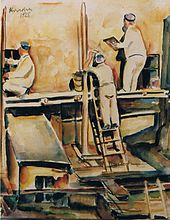
Years from 1800
- Friedrich Wilhelm Dankberg (1819–1866), German sculptor and plasterer
- Lorenz Zotz the Elder (1862–1903), Austrian plasterer
- Josef Schnitzer Sr. (1877–1951), German plasterer
- Hubert Zotz (1875–1960), Austrian plasterer
- Lorenz Zotz the Younger (1902–1985), Austrian plasterer
- Ämilian Zotz (1908–1984), Austrian plasterer
- Josef Schnitzer jun. (1915–1984), German plasterer
- Jan Hooss (* 1963), German sculptor and plasterer
literature
- Alfred Bohnagen: The plasterer and plasterer . Leipzig: Bernhard Friedrich Voigt 1914.
- Paul Binder / Fritz Schaumann / Meinrad Haas: Plasterer manual . Hanover: Schäfer 1996, ISBN 978-3-88746-087-7 .
- Siegfried Leixner / Adolf Raddatz: The plasterer . Handbook for the trade. Plaster, stucco, dry construction, Stuttgart: Julius Hoffmann Verlag 1996 (2nd edition), ISBN 3-87346-074-2 .
Individual evidence
- ↑ Text of the regulation on vocational training in the construction industry
- ↑ http://www.zdb.de/zdb-cms.nsf/id/bildergalerie-stuckateure-de?open&ccm=010020040 Web presentation on the ZDB website .
- ↑ Training regulation for plasterers and drywall builders ( page no longer available , search in web archives ) Info: The link was automatically marked as defective. Please check the link according to the instructions and then remove this notice. (PDF; 43 kB) of the Austrian Ministry of Economic Affairs, valid since 1994.
- ↑ Business access - stucco contractors and dry lining regulations ( Federal Law Gazette II No. 87/2003 ) of the Austrian Ministry of Economics, valid since 2003.
- ↑ Commercial access - heat, cold, sound and fire damper regulation ( Federal Law Gazette II No. 99/2003 ) of the Austrian Ministry of Economics, valid since 2003.
Web links
- Federal association for interior work and facade in the ZDB Internet portal of the umbrella association of plasterers
- German competence center for interior fittings and facades
- Stucco apprentice Professional information portal on the apprenticeship plasterer
- Expansion of the Bachelor (cra) information portal for practical studies in the plastering trade
- National team of the German plastering trade
- Plasterer Professional film from the Federal Employment Agency
- Career and industry information for apprentices and trainers from the Austrian Chamber of Commerce
- Education and training information for plasterers at the Institute for Economic Research: BerufsInformationsComputer (BIC)
- ausbau + fassade is the official organ of the Federal Association for Expansion and Facades in the ZDB
